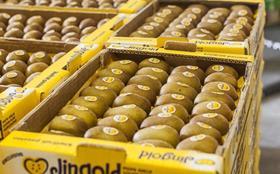
Efforts being made by Italian brand Jingold to develop counter-seasonal production of its yellow-fleshed kiwifruit variety Jin Tao in Latin America are proving successful despite the loss of more than half its current Chilean crop, according to Jordi Casas, technical manager at the group's partner company Frusan and co-ordinator of Jingold's technical task force.
The agronomist said the Jingold project had experienced continuous growth, and that was in part thanks to the development of a Southern Hemisphere supply base in Chile, where a joint venture called Kiwigold Cile set up to do just that has been in operation for some time.
'The development of Jingold in Chile has aroused considerable interest among the growers since the very beginning, mainly thanks to the favorable economic result it allows to achieve compared to the traditional green kiwifruit production,' Casas explains.
'In this context, new orchards have had to be planted, keeping in mind the possible differences created by managing and trying to adapt to the varying climate conditions of the country.'
Figures recently published by Jingold marketer Consorzio Kiwigold suggest the market is placing an increasing premium on the quality of its fruit, with the average per-carton price for Italian-grown Jingold-branded fruit rising to €1.73/kg in 2013/14, an increase of €0.20 compared with the previous campaign.
'Consumers are prepared to pay a premium price for a product which they perceive to be of a high and consistent quality,' comments Jingold president Patrizio Neri. 'Retailers, who work with lower margins on other categories in the department, and producers further up the supply chain who sometimes live in terrible situations with practically no profitability, can all benefit from this added value, because in this case they have a chance to see their investments and their work properly rewarded.'
Growing knowledge
Two years ago, Kiwigold Cile and technicians from Jingold and Frusan launched a new research project to identify best practice in managing production of the variety.
The research was carried out by another agronomist, Matías Kulczewski of the Asesoría técnica y Proyectos de investigación K&R, and included tests to examine pruning, tree fruit load, thinning period, vegetation management, size’ analysis and fruit quality.
'The research provided a first set of important information concerning the density of fruiting branches to keep during the breeding and the pruning stages, the most suitable period to thin the young fruits, the influence of the size of the sprout on the size and quantity of the fruits, the effect of some growth regulators on the quantity of fruits evaluating different rates and different timing of application,' Cass notes.
Further investigation will be required, however. 'Unfortunately, in the present year, some severe frosts have affected the major kiwifruit producing areas causing a loss of 60 per cent of the total production and preventing the staff from continuing the research activities on the above-mentioned new issues.'
Further development of Jingold in Chile will require an examinination of ripening and post-harvest management, taking into account the varied climate conditions found in production areas and their distance to market.
For this reason, Kiwigold Cile is undertaking further research with Jingold's backing.
'Jingold gives the Chilean agricultural enterprises the great opportunity to improve their profits and, if properly managed as it has been until now, it represents an excellent alternative on the overseas markets because Jingold kiwifruit is a fruit capable of meeting the needs of the most demanding consumers on markets throughout the world.'



